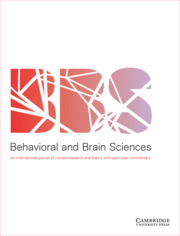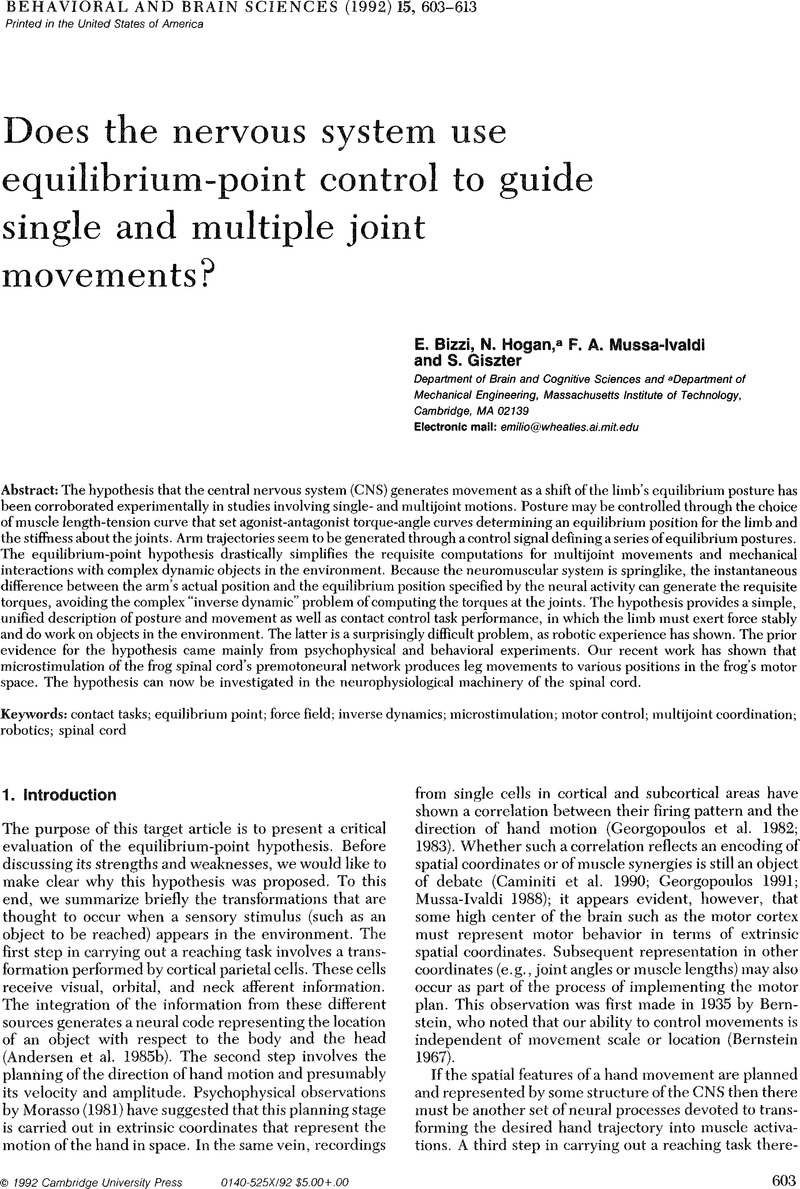Crossref Citations
This article has been cited by the following publications. This list is generated based on data provided by Crossref.
Latash, Mark L.
and
Zatsiorsky, Vladimir M.
1993.
Joint stiffness: Myth or reality?.
Human Movement Science,
Vol. 12,
Issue. 6,
p.
653.
St-Onge, Nancy
Qi, Haiming
and
Feldman, Anatol G.
1993.
The patterns of control signals underlying elbow joint movements in humans.
Neuroscience Letters,
Vol. 164,
Issue. 1-2,
p.
171.
Haggard, Patrick
Miall, Chris
and
Stein, John
1995.
Twisted pairs: Does the motor system really care about joint configurations?.
Behavioral and Brain Sciences,
Vol. 18,
Issue. 4,
p.
758.
Alexandrov, Alexey
Frolov, Alexander
and
Massion, Jean
1995.
Is the multi-joint pointing movement model applicable to equilibrium control during upper trunk movements?.
Behavioral and Brain Sciences,
Vol. 18,
Issue. 4,
p.
745.
Nichols, T. Richard
1995.
Interneurons as backseat drivers and the elusive control variable.
Behavioral and Brain Sciences,
Vol. 18,
Issue. 4,
p.
772.
Goodman, Simon R.
1995.
Inverse kinematic problem: Solutions by pseudoinversion, inversion and no-inversion.
Behavioral and Brain Sciences,
Vol. 18,
Issue. 4,
p.
756.
Gielen, C. C. A. M.
and
van Bolhuis, B.
1995.
Reciprocal and coactivation commands are not sufficient to describe muscle activation patterns.
Behavioral and Brain Sciences,
Vol. 18,
Issue. 4,
p.
754.
Kay, Bruce A.
1995.
Frames of reference interact and are task-dependent.
Behavioral and Brain Sciences,
Vol. 18,
Issue. 4,
p.
765.
Patla, Aftab E.
1995.
The λ model: Can it walk?.
Behavioral and Brain Sciences,
Vol. 18,
Issue. 4,
p.
775.
Fidelman, Uri
1995.
The lambda model and a hemispheric motor model of intentional hand movements.
Behavioral and Brain Sciences,
Vol. 18,
Issue. 4,
p.
750.
Hodgson, Antony
1995.
The unobservability of central commands: Why testing hypotheses is so difficult.
Behavioral and Brain Sciences,
Vol. 18,
Issue. 4,
p.
763.
Sternad, Dagmar
and
Turvey, M. T.
1995.
Control parameters, equilibria, and coordination dynamics.
Behavioral and Brain Sciences,
Vol. 18,
Issue. 4,
p.
780.
Desmurget, Michel
Rossetti, Yves
and
Prablanc, Claude
1995.
Natural unconstrained movements obey rules different from constrained elementary movements.
Behavioral and Brain Sciences,
Vol. 18,
Issue. 4,
p.
750.
Alexander, R. McN.
1995.
Tendon elasticity and positional control.
Behavioral and Brain Sciences,
Vol. 18,
Issue. 4,
p.
745.
Loeb, Gerald E.
1995.
What can we expect from models of motor control?.
Behavioral and Brain Sciences,
Vol. 18,
Issue. 4,
p.
767.
Latash, Mark L.
1995.
Equilibrium-point control? Yes! Deterministic mechanisms of control? No!.
Behavioral and Brain Sciences,
Vol. 18,
Issue. 4,
p.
765.
Partridge, Lloyd D.
1995.
Let us accept a “controlled trade-off” model of motor control.
Behavioral and Brain Sciences,
Vol. 18,
Issue. 4,
p.
773.
van Emmerik, R. E. A.
and
Wagenaar, R. C.
1995.
Equifinality and phase-resetting: The role of control parameter manipulations.
Behavioral and Brain Sciences,
Vol. 18,
Issue. 4,
p.
783.
Feldman, Anatol G.
and
Levin, Mindy F.
1995.
The origin and use of positional frames of reference in motor control.
Behavioral and Brain Sciences,
Vol. 18,
Issue. 4,
p.
723.
Pagano, Christopher C.
and
Bingham, Geoffrey P.
1995.
Spatial frames for motor control would be commensurate with spatial frames for vision and proprioception, but what about control of energy flows?.
Behavioral and Brain Sciences,
Vol. 18,
Issue. 4,
p.
773.



